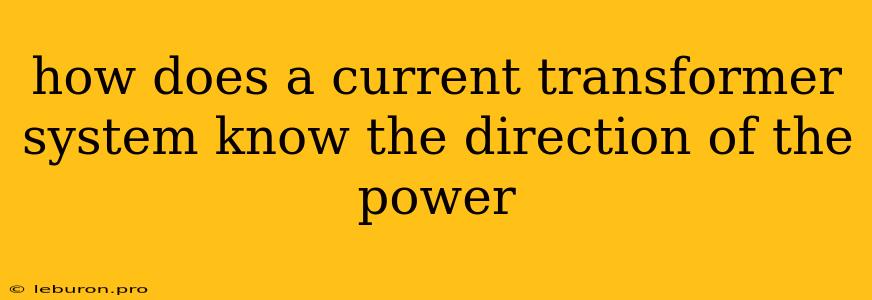Understanding the intricate workings of a power system requires delving into the fundamental principles that govern its operation. Among these principles, the ability to determine the direction of power flow is crucial for efficient and reliable energy distribution. This article explores how a current transformer (CT) system ingeniously identifies the direction of power flow, a capability essential for monitoring, protection, and control within electrical grids.
The Role of Current Transformers in Power Systems
Current transformers (CTs) are essential components in power systems, serving as crucial instruments for measuring and monitoring electrical currents. They act as miniature transformers, reducing high-voltage currents in power lines to safe levels that can be handled by metering and protection equipment. This reduction is achieved through a specific ratio determined by the number of turns on the primary and secondary windings of the CT. However, the significance of CTs extends far beyond simple current measurement; they play a pivotal role in determining the direction of power flow.
The Principle of Power Flow Direction Determination
The principle behind power flow direction determination using CTs lies in understanding the relationship between current and voltage. In a power system, the direction of power flow is dictated by the phase angle difference between the current flowing through the system and the voltage across it. This phase angle provides a crucial indicator of whether power is being delivered (flowing into a load) or being received (flowing back from a source).
The Mechanics of Direction Determination
CTs are specifically designed to capture the phase relationship between current and voltage. They achieve this by utilizing the phenomenon of electromagnetic induction. When an alternating current flows through the primary winding of a CT, it creates a changing magnetic field. This changing magnetic field induces a corresponding current in the secondary winding, which is connected to metering or protection equipment.
The key to determining the direction of power flow lies in the phase relationship between the current in the primary winding and the induced current in the secondary winding. If the current in the primary winding and the induced current in the secondary winding are in phase, it indicates that power is flowing in one direction. Conversely, if the current in the primary winding and the induced current in the secondary winding are out of phase, it signifies power flow in the opposite direction.
Applications of Power Flow Direction Determination
The ability to accurately determine the direction of power flow has numerous practical applications within power systems:
1. Protection of Power Equipment:
CTs are instrumental in protecting power equipment from overcurrents and faults. By detecting the direction of power flow, protection relays can isolate faulty sections of the system, preventing damage and ensuring the integrity of the entire grid. This is essential for preventing cascading failures and maintaining system stability.
2. Load Management:
Power utilities use CTs to monitor power flow and manage loads effectively. By understanding the direction and magnitude of power flow, utilities can allocate power resources efficiently, optimize energy distribution, and prevent overloads on specific sections of the grid.
3. Metering and Billing:
CTs form the cornerstone of metering systems used to measure and bill consumers for electricity consumption. They enable the accurate measurement of energy consumption, both in terms of quantity and direction of flow.
4. System Monitoring and Control:
CTs play a vital role in real-time monitoring and control systems. They provide valuable data on power flow patterns, helping operators to optimize system performance, anticipate potential problems, and make informed decisions regarding system adjustments.
Conclusion
Current transformer systems are an essential part of modern power systems, offering a powerful tool for determining the direction of power flow. This capability is vital for ensuring the safe, reliable, and efficient operation of electrical grids. By understanding the principles behind the direction determination, engineers and operators can effectively monitor and control power flow, ultimately enhancing the performance and resilience of power systems. The intricate dance of current and voltage, captured by the ingenious design of CTs, allows for the precise identification of power flow direction, a critical aspect of power system operation and management.
